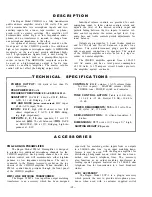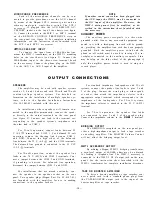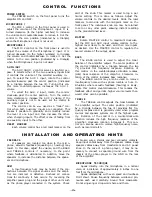
MICROPHONE PRECEDENCE
E a c h o f t h e m i c r o p h o n e c h a n n e l s c a n b e c o n -
nected to provide precedence over the AUX channel
by means of the Bogen LVP-1 accessory unit and an
ordinary single-pole, single-throw switch. The LVP-1
a c c e s s o r y i s p l u g g e d i n t o t h e A U X R E M O T E A C -
CESSORY socket on the top of the chassis (see figure
3). Connect the switch to the MIC 1 or MIC 2 terminal
on the REMOTE CONTROL PRECEDENCE strip on
the rear panel (see figure 2). For complete installation
information, see the instruction sheet furnished with
the LVP-1 and RVP-1 accessories.
WMT-I
ACCESSORY INPUT
T o c o n n e c t t h e i n p u t f r o m a 5 0 0 / 6 0 0 - o h m l i n e ,
mount the WMT-1 transformer on the WMT-1 mounting
holes on the rear chassis (see figure 2). Connect the
500/600-ohm i n p u t t o t h e t h r e e - s c r e w t e r m i n a l b o a r d
on the accessory. Connect the phono plug on the WMT-
1 to the AUX 1 or AUX 2 input of the amplifier.
NOTE
If another sound source has been plugged into
the AUX input, the WMT-1 may be connected to
the M I C i n p u t o f t h e a m p l i f i e r . H o w e v e r , t h e
WMT-1 wiring must first be modified, as de-
scribed in the instruction sheet furnished with
the accessory.
AUXILIARY POWER
T h e a u x i l i a r y p o w e r r e c e p t a c l e i s a t h r e e - w i r e
grounded outlet. Hence, any associated equipment con-
nected to it with a three-prong line cord will be ground-
ed, providing the amplifier line cord has been properly
g r o u n d e d . B o t h t h e a m p l i f i e r p o w e r s w i t c h a n d t h e
phono on-off switch must be used in turning off a re-
cordplayer connected to the auxiliary receptacle. Flats
may develop on the idler wheel of the phonograph if
only the amplifier power switch is used to stop the
record player.
SPEAKERS
The amplifier may be used with speaker systems
rated at 2, 8 and 16 ohms and with 25-volt and 70-volt
c o n s t a n t - v o l t a g e s p e a k e r s y s t e m s . F o r d e t a i l e d i n -
formation on the installation of multiple speaker sys-
t e m s , r e f e r t o t h e S p e a k e r I n s t a l l a t i o n I n s t r u c t i o n s
(No. 54-5001-02) included with this unit.
I n i n s t a l l a t i o n s w h e r e s p e a k e r s w i l l r e m a i n c o n -
nected to the amplifier permanently, connect the speak-
er directly to the output terminals on the rear panel
(see figure 2). Connect one lead to the terminal cor-
r e s p o n d i n g t o t h e s p e a k e r s y s t e m ’ s i m p e d a n c e a n d
the other lead to COM 1.
For 25-volt operation, connect leads between 25
V (6-8
terminal and COM 1. For balanced 25-volt
operation, remove the shorting link between COM 1
a n d G N D . C o n n e c t t h e h i g h s i d e s o f t h e b a l a n c e d
line between the 25 V (6-8
and the COM terminals.
The balanced line ground is connected to the 25 VCT
(1.5-2
terminals.
For 70-volt o p e r a t i o n ,
c o n n e c t t h e s p e a k e r l i n e
leads to the 70 V (4912) and COM 2 terminals. Con-
nect a jumper between the COM 2 and GND terminals,
if grounding is desired. For balanced line operation,
disconnect the jumper between COM 2 and GND.
For installations that are moved constantly, con-
n e c t t h e s p e a k e r t o t h e s p e a k e r s o c k e t o n t h e r e a r
panel. Two speaker plugs (Bogen Part No. 85-0147-01)
a r e f u r n i s h e d w i t h t h e a m p l i f i e r f o r u s e i n making
connections to the speaker sockets.
O U T P U T C O N N E C T I O N S
For standard impedance loudspeakers and 25-volt
systems, connect the speaker line leads to pins 1 and
2 of the plug. Connect the wired plug to either speak-
e r s o c k e t , t h e n a t t a c h t h e i m p e d a n c e s e l e c t o r t o t h e
appropriate output terminal which corresponds to the
i m p e d a n c e o f t h e l o u d s p e a k e r . F o r 2 5 - v o l t s y s t e m s ,
the impedance selector is attached to the 25 V (6-812)
terminal.
F o r 7 0 - v o l t o p e r a t i o n ,
t h e s p e a k e r l i n e l e a d s
a r e c o n n e c t e d t o p i n s 2 a n d 3 o f t h e s p e a k e r p l u g .
Connect the impedance selector to the
COM
2 terminal.
BRIDGING OUTPUT
The BRIDGING receptacle on the rear panel pro-
vides a high-impedance output to feed a tape recorder
or auxiliary amplifier. The MASTER Volume Control
will not affect the bridging output level.
WMT-I ACCESSORY OUTPUT
By utilizing a Bogen WMT-1 bridging transformer,
a zero-level output at 500/600 ohms may be obtained
for feeding a telephone line. The WMT-1 accessory is
connected to the WMT-1 HI Z output jack on the rear
p a n e l . S e e t h e i n s t r u c t i o n s h e e t f u r n i s h e d w i t h t h e
WMT-1 transformer for complete installation directions.
TAPE OR BOOSTER AMPLIFIER
To drive a booster amplifier or tape recorder, con-
nect a patch cord (with a standard phono plug) from
the TAPE/BOOSTER output jack to the input of the
booster amplifier or tape recorder.
-5-
Содержание CHS100
Страница 8: ......


























